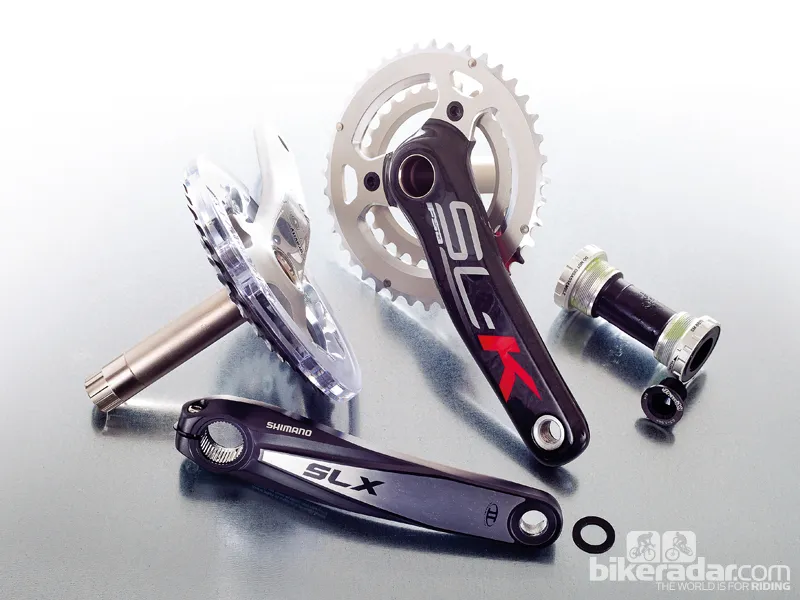It’s looking like 2012 will be the year that double cranksets – those with twin chainrings instead of the traditional three – begin to dominate. With no outer chainring to catch on logs and rocks, and less chain flapping around, they make sense for more aggressive riders, and with the latest wide-range 10-speed cassettes you shouldn't be short of gears. Here's our pick of the best mountain bike doubles we've tested this year.
Best double cranksets
Winner: Shimano Deore XT M785
£195/$320

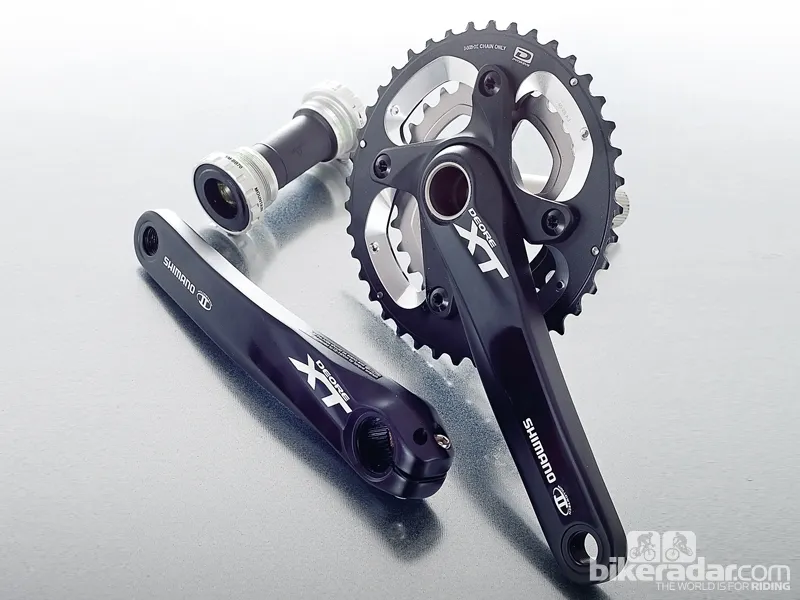
Shimano lagged behind rivals SRAM when it came to introducing 2x10 chainsets but they appear to have made up for that by improving on last generation XT with super-stiff big-profile arms, a new spider design and meticulously profiled rings that remain slick, quiet and accurate even when shifting under extreme pedal pressure. Weight is impressive for such a stiff crankset, too.
Click here to read BikeRadar's full review of the Shimano Deore XT M785 double.
Joint value winner: FSA Comet 386
£120/$175

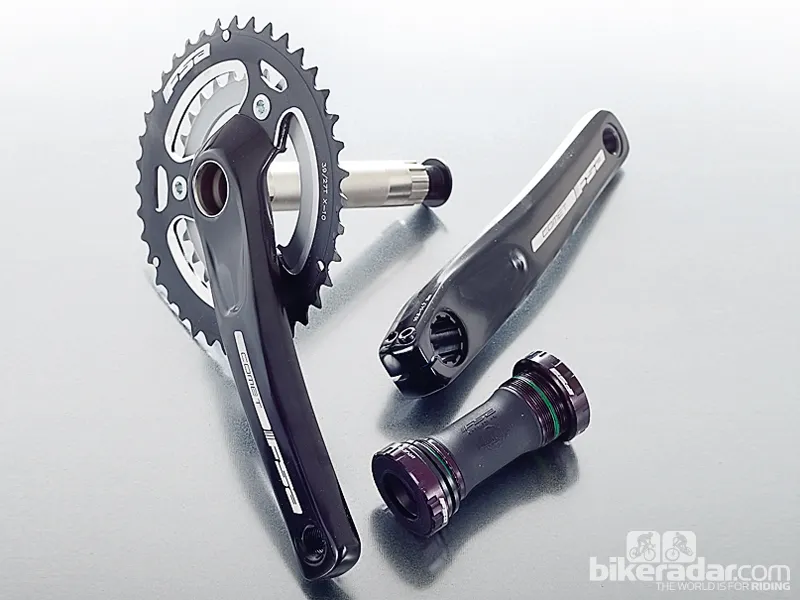
The reasonable price of the 386 makes it a great choice for anyone who regularly damages kit. Wide-profile scalloped arms are stiff and the wide three-arm spider gives lots of support to the rings. It’s a durable setup that can handle punishment. Shifting is reliable, if slightly clunkier under power than more upmarket cranks. All-in weight still compares with more costly units.
Click here to read BikeRadar's full review of the FSA Comet 386 double.
Joint value winner: SRAM X5
£113/$190

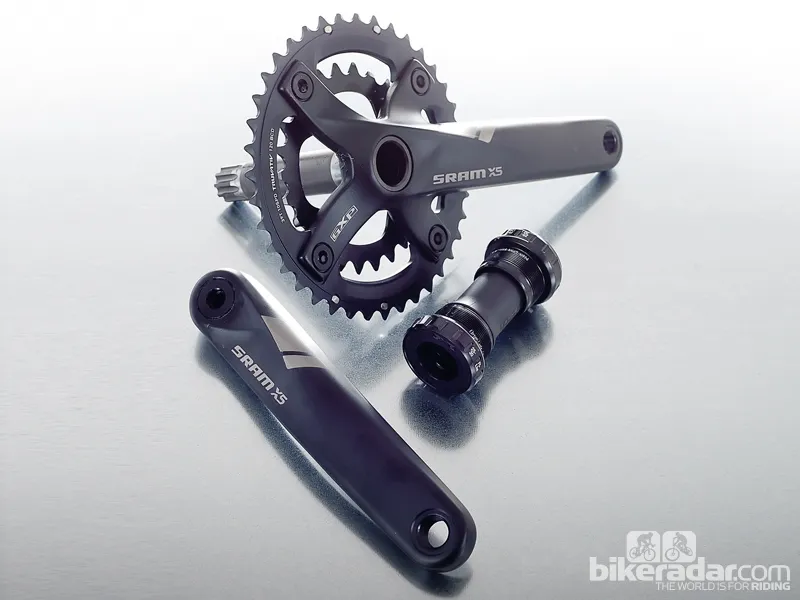
Considering that a lot of top-end cranksets only weigh 100g or so less than this and are almost imperceptibly stiffer, opting for the SRAM X5 is a wise buying decision for most riders. The beauty of a crankset like this is that it’s equally good for beginners and experts alike. Weight is reasonable and the price is so good that’s you’re probably better off replacing the whole unit when the rings wear.
Click here to read BikeRadar's full review of the SRAM X5 double.
FSA Afterburner 386
£190/$240

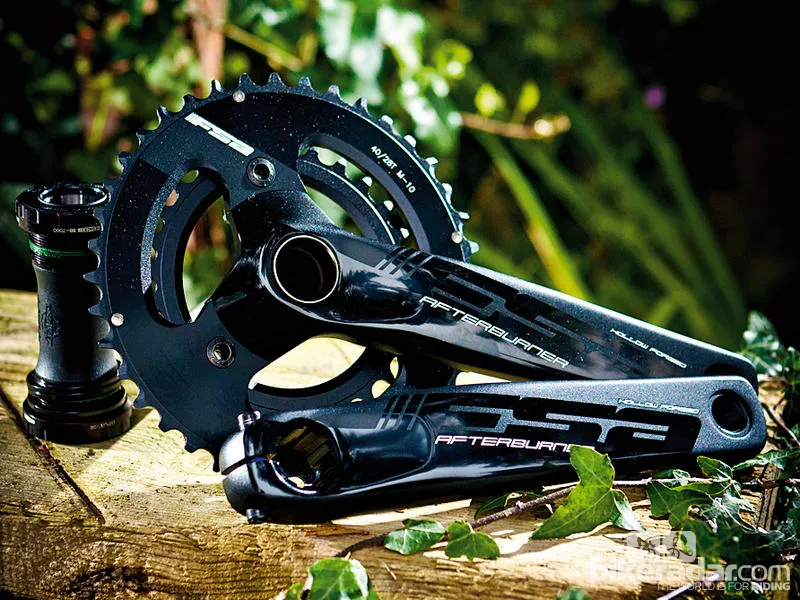
One of the first tough trail double chainsets is still a great value, durable all-rounder. The combination of broad hollow-forged arms and oversized chromoly steel axle has proved strong and stiff in the several years we’ve been using these cranks. They fit easily and stay secure, and there’s a lighter, stiffer alloy axle BB30 version for bikes fat enough to take it.
Click here to read BikeRadar's full review of the FSA Afterburner 386 double.
Gravity Light 7050 MegaExo
£220/$289

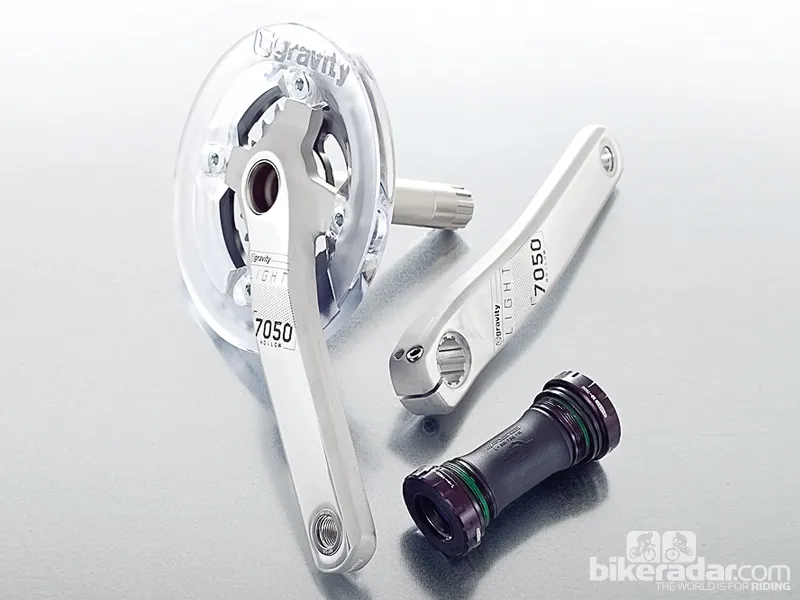
This hollow forged crankset is designed for heavy-duty big terrain duties. It's super-tough without carrying around any excess weight. Chromoly steel pedal inserts add durability, as does a chunky polycarbonate bashring, which is ideal for hopping across logs and rocks in a clumsy/carefree manner without possible outer chainring damage. The nicely profiled rings ensure excellent shifting.
Click here to read BikeRadar's full review of the Gravity Light 7050 MegaExo double.
Shimano SLX M665
£150/$240

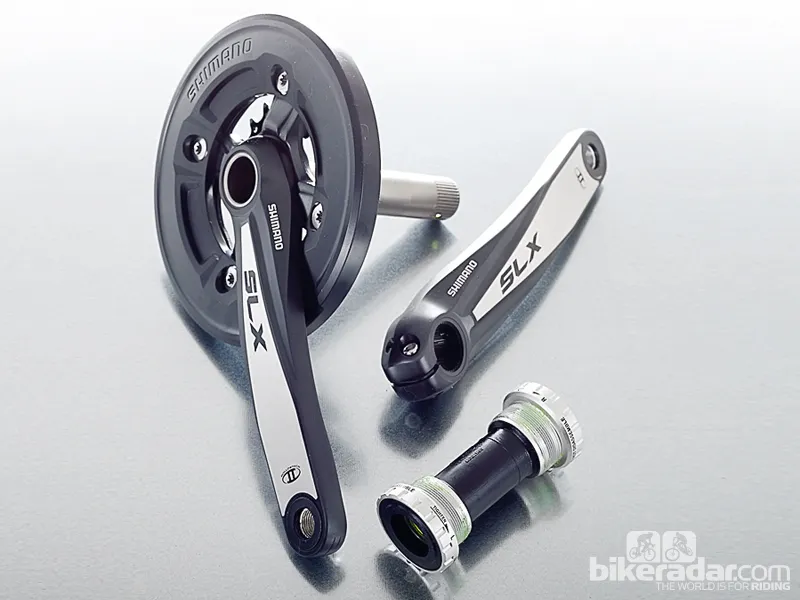
The wide section hollow crank arms are very stiff and the bare outer surface stays scuff-free for far longer than black cranks. A burly steel axle and steel pedal inserts hint at the cranks’ intended hard hitting abilities, as does the fat polycarbonate bash guard. But the weight is still reasonable enough for cranks like this to appeal to ‘normal’ trail riders.
Shimano XTR Trail M980
£435/$649

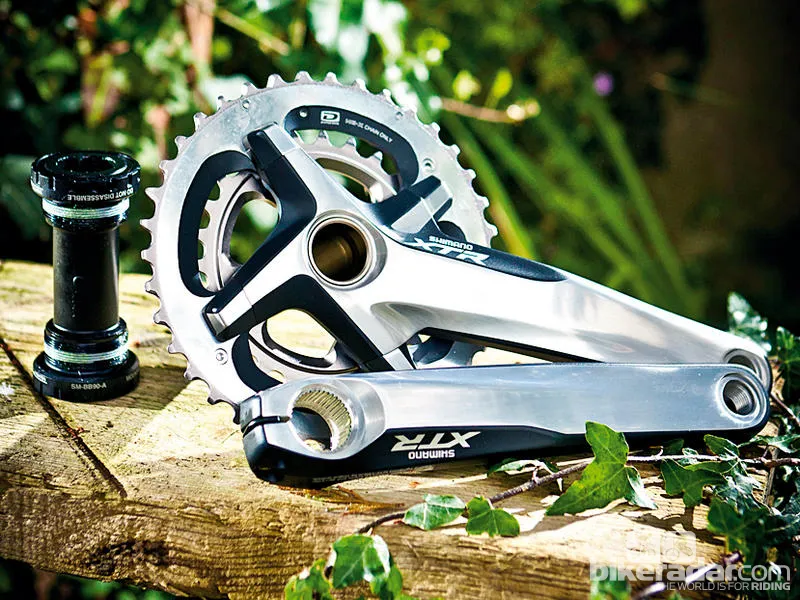
Shimano’s flagship unit proves you don’t need cosmetically compromised carbon to make a super-stiff, lightweight crankset. At 670g, it’s a very light double setup, but the polished alloy outer face means our year-old set still looks brand new. We’ve not trodden on anything stiffer in a conventional format either – and we’ve taken some big old drops.
Click here to read BikeRadar's full review of the Shimano XTR Trail M980 double.
Truvativ X9
£200/$285

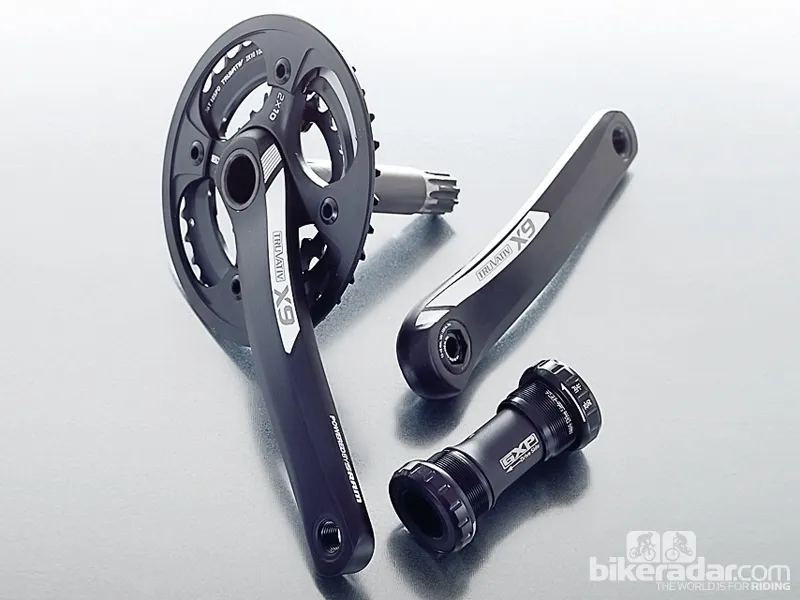
This is essentially SRAM’s X9 crankset made compatible with 2x10 drivetrains but with a tough aluminium bash guard (£34) instead of an outer chainring to deflect log and rock hopping damage. It’s a lightweight option compared to most bash guard setups, which makes it more suitable for those who ride with finesse but still prefer a precautionary guard rather than having the bigger gear ratios of an outer ring.
Click here to read BikeRadar's full review of the Truvativ X9 double.
Things to bear in mind when buying a double crankset
You don't always get what you pay for: While the top-end carbon-based cranksets are undoubtedly things of beauty, they’re not much lighter than top-end aluminium-based cranksets and on the whole they don’t seem to last any longer. We'd opt for good value, sub-£200, every time, and SRAM, FSA and Shimano can all come up with winners in that market sector.
Ditching a chainring doesn't mean losing one-third of your gears: The conventional triple chainring setup leads to overlapping of gears, so a 3x10 drivetrain may only yield 18 or so unique ratios. This overlap is reduced on a double, and trouble-free chain lines mean there are no sprocket combos you can’t use.
Switching to a double won't save much weight: You might not be saving more than 50g by doing without a granny ring, so don’t choose a double on weight grounds.
Be careful with your gear ratios if you're not super-fit: Some bigger ringed doubles can leave you running out of gears on steep climbs; go for 26 teeth or fewer if you have fitness doubts.
Cranks that look good on the shop floor don't always stay that way on the trail: While we like the look of black cranksets, the silver or polished outer crank surface options stay looking good for more rides.
Anatomy of a crankset
Chainrings
Almost all manufacturers use shaped teeth, ramps and pins on the inner edge of chainrings to help guide the chain between the rings. Some are more efficient than others, but front gear mech positioning and adjustment is equally important. Only having two rings cuts down on chain line problems and, if twinned with a shorter axle, results in a shorter distance between your feet (Q factor), said to be more efficient for pedalling.
Axles
Different cranks use different spline setups on the axle. Some slide onto the spline and are fastened tight by a bolt threaded into the end of the axle. Others involve the crank being pinch tightened around them. In both cases, spacers dictate ideal positioning for chain line, crank clearance and a snug fit with smooth-running bearings and no play.
Bottom bracket
Square-taper bottom bracket axles with cups and bearings inside the frame shell are still available but most new cranksets now have an oversized hollow axle fixed to one crank, a splined axle onto which the other crank is bolted and bearings that fit into cups outside the frame’s BB shell.
We’re not testing BB30 or other oversized cups/axles in this test, but it’s worth being aware that they’re creeping in at the top end of the market as a way of trimming weight and boosting drive stiffness on top end frames. A BB30 bottom bracket has bearing cups that press-fit into the frame.
Bash guards
If your rides involve log hops and/or rocky step riding, you’ll probably already know that slamming the big ring on logs/rocks will damage the teeth. Double cranksets have smaller outer rings, reducing this problem, or you could get a crankset with a bashguard instead of the big chainring.
Stiffness and weight
Extra weight can add stiffness to cranks just as less weight can add flexibility. The skill of making great cranks at any price is to create stiffness where it’s useful while trimming weight where it’s not. Just don’t expect very light and very stiff. There’s usually a trade-off.
This article is based on reviews originally published in What Mountain Bike (available on Apple Newsstand and Zinio) and Mountain Biking UK (also available on Apple Newsstand and Zinio).
